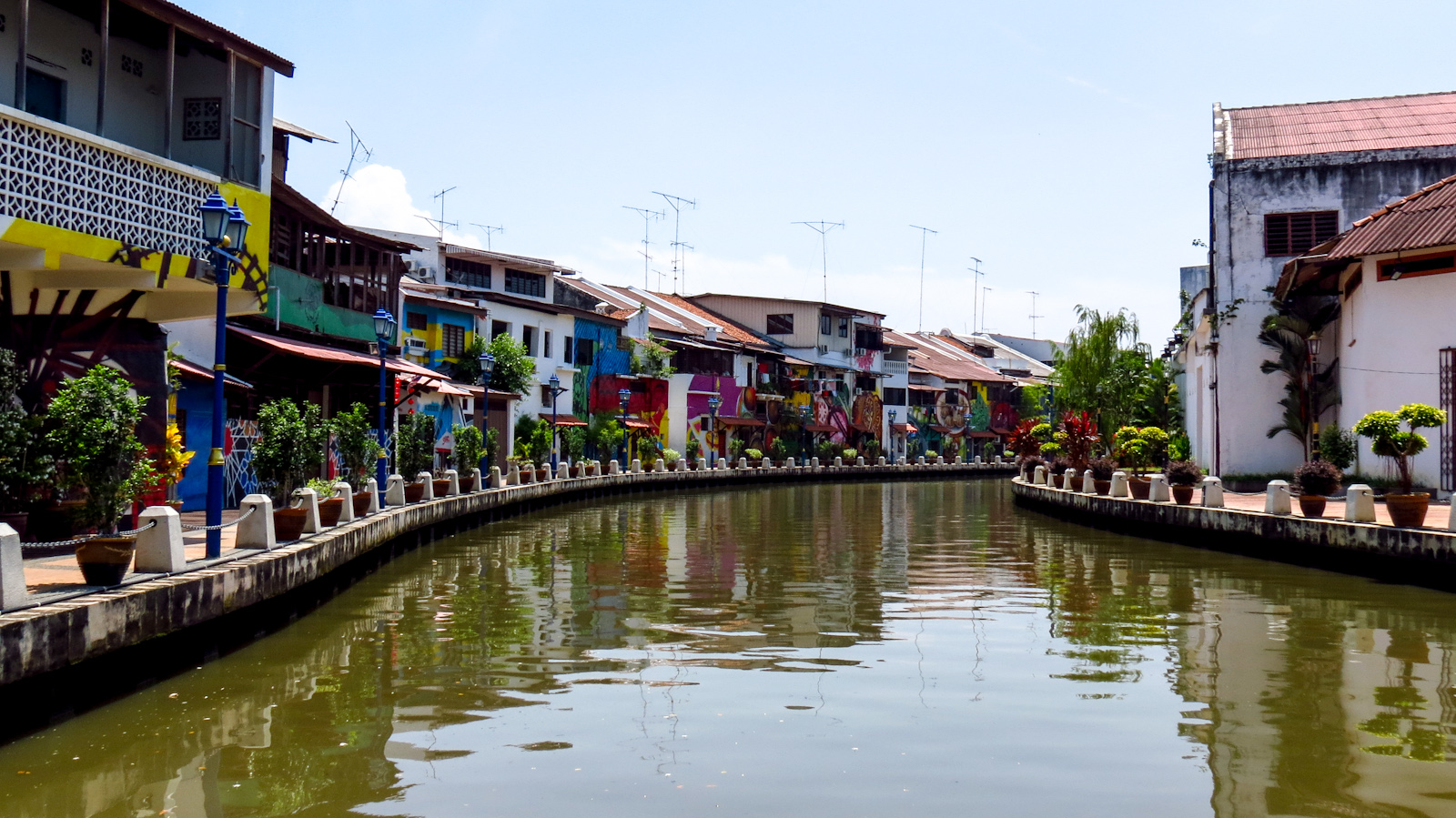Malacca’s little known art walk
Malacca is a small costal town in Malaysia that is starting to get recognition as a must see on the Southeast Asian travel loop. Located two hours south of Kuala Lumpur, Malacca offers a great mix of culture, history and travel ambiance that allows backpackers and regular travelers alike to find something they will enjoy.
While Malacca may not be the place to visit if you are looking for a challenging travel experience, its rich art culture is enough for any aspiring creative to find inspiration. Along the winding streets surrounding Jonker Walk (home of a fantastic night market) visitors will find a mélange of local and foreign art stores, surrounded by hip cafes and ranging accommodation. Art shops on the streets offer anything from paintings to sculpture, and one can even find a body art shop if they look in the right place.
One of the most intriguing sights about Malacca is the hidden street art, done by up and coming tag artists, all around the city. In alleyways, under bridges and often times in plain view, the street art of Malacca is sight to see for anyone interested in urban tag and street art.
The most prominent source for street art is along the river walk that cuts through the city. Starting at the bridge near the newly opening Hard Rock Café Malacca, art enthusiasts can follow the river as it lazily moves by. As cafes and guesthouses start to subside, the walls become filled with bright, beautiful art. Depictions range from Malaccan history to folk figures to beautiful scenery, and each building seems to have it’s own dynamic artist covering the space. The buildings with art run for around a one kilometer span, and can be viewed from either side of the river. For those who enjoy photography, hit the side of the river opposite the art in the early morning for great shots of the art reflected on the water.
If you prefer to ride rather than walk the kilometer, River cruise boats run about every ten minutes from the early afternoon until the late evening. Regardless of what you are looking for in your travels, make sure to stop in Malacca. The art walk alone is enough of a reason to make a day trip. Beware though, the charming city, great weekend markets and extravagant selection of food will keep you there for longer than you expected.
Alan Webb returns to Oregon to train with Jerry Shumacher
Oh, Alan Webb. What more can be said about the infamous American Mile Record holder? After busting on to the scene in high school, Webb has been a mercurial force that comes and goes with the wind. One season he will break American Records, while the next, he will barely break the tape while racing collegiate competition. Regardless of one’s stance on Webb, there is a new hope that this new change of scenery will be enough to push Webb back to the elite level he once competed at.
Announced early this week through a Flotrack interview, Alan Webb has decided to return to Oregon to train under head coach Jerry Schumacher. In his announcement, Webb also let insatiable distance running fans know that he is going to bump up in distances, focusing solely on the 5K and 10K races. Though he hasn’t ruled out the marathon, after training for the longer distances, Webb said it may be, “a little bit further away then I thought.”
In the past 3 ½ years, Webb has had four coaches, and little in the way of results. He has run some solid times for an elite, but not for an American Record holder thought to be a threat on the international level. In his interviews, Webb acknowledged poor performances, and takes an introspective and mature approach to moving forward. He said, “At times, patience hasn’t been my strong suit but it’s one of the things I’m trying to learn – or I feel that I have learned. Sometimes things just have to work themselves out. There has been a little bit of frustration involved (for me), but looking back I would think it would be understandable – at least in my mind. It hasn’t been a super awesome road for me athletically.”
While some may scoff at the idea of Webb emerging as a threat in longer distances, in the past, he has run 27:34:72 for the 10K, as well as for the 13:10 5K. With his speed and strength, Webb has the ability to be a top 5K and 10K performer, but having just turned 30, time may be against the former prep star.
Along with the new coach, Webb will be training with some of the best distance stars in the U.S. (and on the planet) in Chris Solinsky, Matt Tegenkamp, Evan Jager and up-and-comers Chris Derrick and German Fernandez. Only time will tell of the journeyman has found a new home, and new inspiration, in Portland.
Picking Sims 3 wildflowers for fun and profit
One of the many new features that comes with the Seasons expansion pack is the existence of wildflowers. These join the ranks of gems, rocks, and insects as collectibles that can bring in lots of Simoleons if you set out to find and sell them. Although unlike the other collectibles, wildflowers do not show up on the Collection Helper Lifetime Reward object. This can make them harder to find, but the challenge is worth it!
Lost cat travels 190 miles home
Last November, Jacob and Bonnie Richter took their cat Holly on vacation with them. They traveled in their motor home from West Palm Beach to Daytona, Florida. Holly, a four year old tortoiseshell, was doing pretty well until someone set off fireworks too close to the Richters' motor home. Holly shot out the open door and was gone in a flash.
Knitting a better pair of fingerless mitts
Knitters love to knit fingerless mitts, and luckily a lot of non-knitters love to get them as gifts. Fingerless mitts are one of those things where you need a lot of different pairs, because they are forever getting lost, abandoned, accidentally ruined, or just given away to someone else who needs them more. I go through at least two pairs a year, not counting the pairs I knit to give away to people.
Nuclear Weapons and Nuclear Power Opposition
The nuclear power industry was spawned by research that developed nuclear weapons. The U.S. government pushed the idea of the Peaceful Atom in the 1950s partly to ally the public’s fears of nuclear technology resulting from the bombing of Japan at the end of World War II. It also was seen as a way to invest more funds in nuclear research than would have been made available by Congress for weapons development.
As time went by and other countries joined the nuclear weapons club, the parallel development of nuclear power generation continued. Some of the same materials and equipment that are necessary for creating nuclear reactor power stations can also be used to purify uranium to the point where it can be used in nuclear weapons. Plutonium can be extracted from nuclear reactor waste for use in nuclear weapons. While the countries with peaceful nuclear reactor power generation generally are in favor of other countries supplementing their internal power generation with nuclear reactors, those countries which currently possess nuclear weapons are in favor of disarmament and prevent the spread of nuclear weapons. The fact that a country can possibly develop nuclear weapons under the guise of developing a nuclear program for power generation is currently roiling the international scene as accusations of such actions are being leveled at Iran.
The global anti-nuclear movement in growing and the international trend is toward nuclear disarmament. I strongly support their efforts to make the world safer and I will devote space in my blog to their work. The problem of nuclear proliferation is one of the arguments against the use of nuclear reactions to produce electrical power but, however important, confuses the issue when talking about the pros and cons of nuclear power on its own merits.
I will be devoting a great many of my future blog posts to the arguments against nuclear power. The proponents of nuclear power have powerful and rich corporations on their side as well as many government agencies both here and abroad. Their side of the argument is well represented in speeches, advertisements, government programs, books, magazine, etc. I want to contribute in my own way to making certain that the argument against nuclear power is equally well presented to the public.
One of the big problems with the opposition to nuclear power is that it is often in the form of fighting against a particular problem associated with nuclear companies and nuclear facilities. One group is opposing a particular mine, another group is trying to prevent a nuclear reactor from being built or restarted, a third group is attacking a plan to site a nuclear processing plant, a forth is attempting to stop the creation of a nuclear waste facility. There are many other groups with specific concerns that are working against the nuclear industry. But the proponents of nuclear power are bigger, richer, more influential and more unified in their actions and goals than any one interest group opposing them. My blog will try to cover as many of the major problems with nuclear power generation as possible as well as highlighting groups working to solve all of these problems.
Can being cold give you a cold?
When I was a kid, I used to love it when my grandmother would tell me to put on a sweater or I'd catch cold, allowing me to snottily retort that "Viruses cause colds, not temperature!" (I was such an insufferable child. It's a wonder I was allowed to live.) But the truth is, my grandmother may have been right.
North Korea: Pot smoker's paradise
Welcome to sunny North Korea, where the Auspicious Leader cares for everyone equally, and there is no poverty or starvation! Just marijuana aplenty!
Geiger Counter Readings in Seattle, WA on January 15, 2012
Geiger Counter Readings in Seattle, WA on January 15, 2012
Ambient office = .094 microsieverts per hour
Ambient outside = .070 microsieverts per hour
Soil exposed to rain = .067 microsieverts per hour
Fresh eggs from grocery store = .100 microsieverts per hour
Tap water = .106 microsieverts per hour
Filtered water = .076 microsieverts per hour
Geiger Counter Readings in Seattle, WA on January 14, 2012
Geiger Counter Readings in Seattle, WA on January 14, 2012
Ambient office = .108 microsieverts per hour
Ambient outside = .156 microsieverts per hour
Soil exposed to rain = .122 microsieverts per hour
Imperial gouda cheese from grocery store = .081 microsieverts per hour
Tap water = .100 microsieverts per hour
Filtered water = .095 microsieverts per hour









